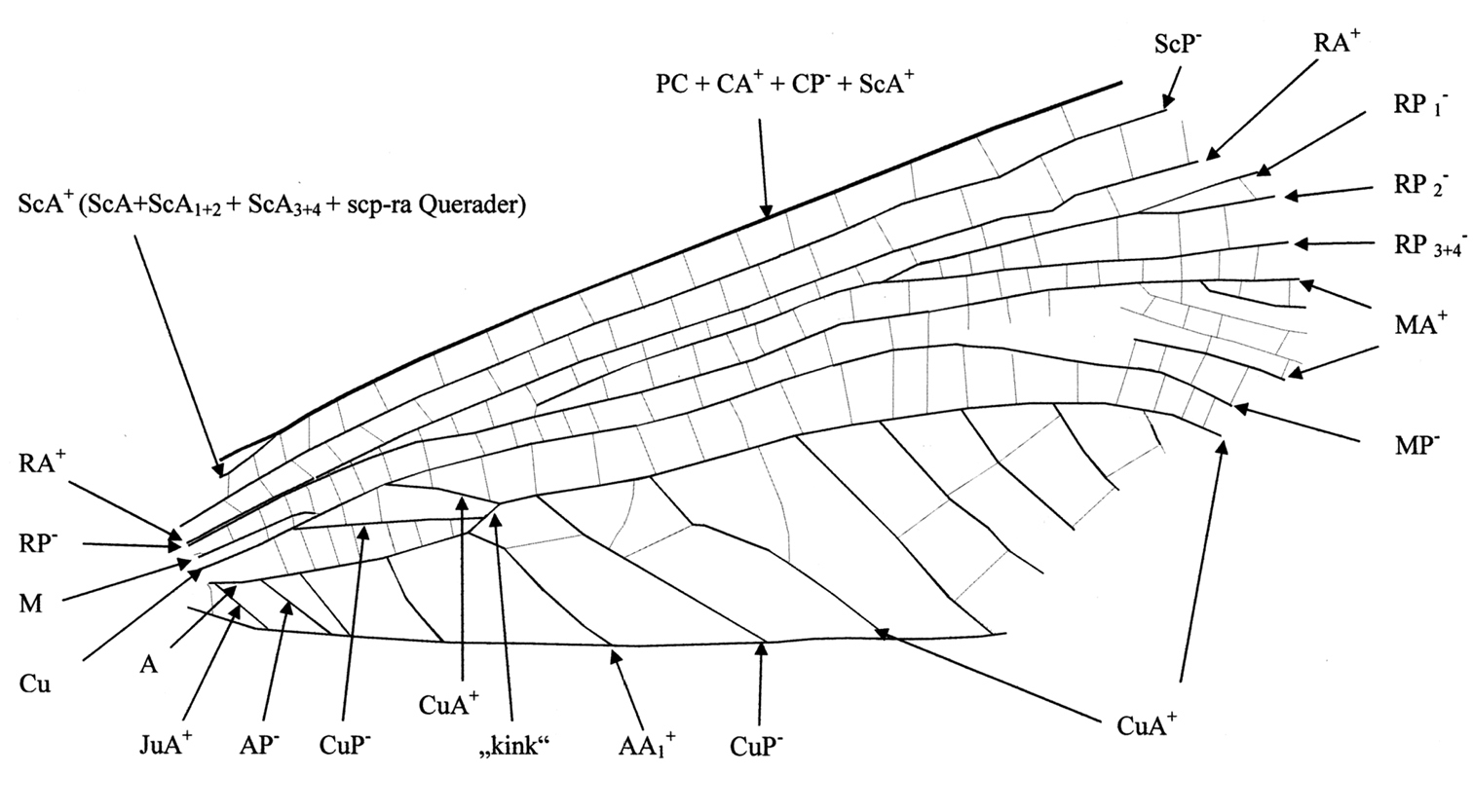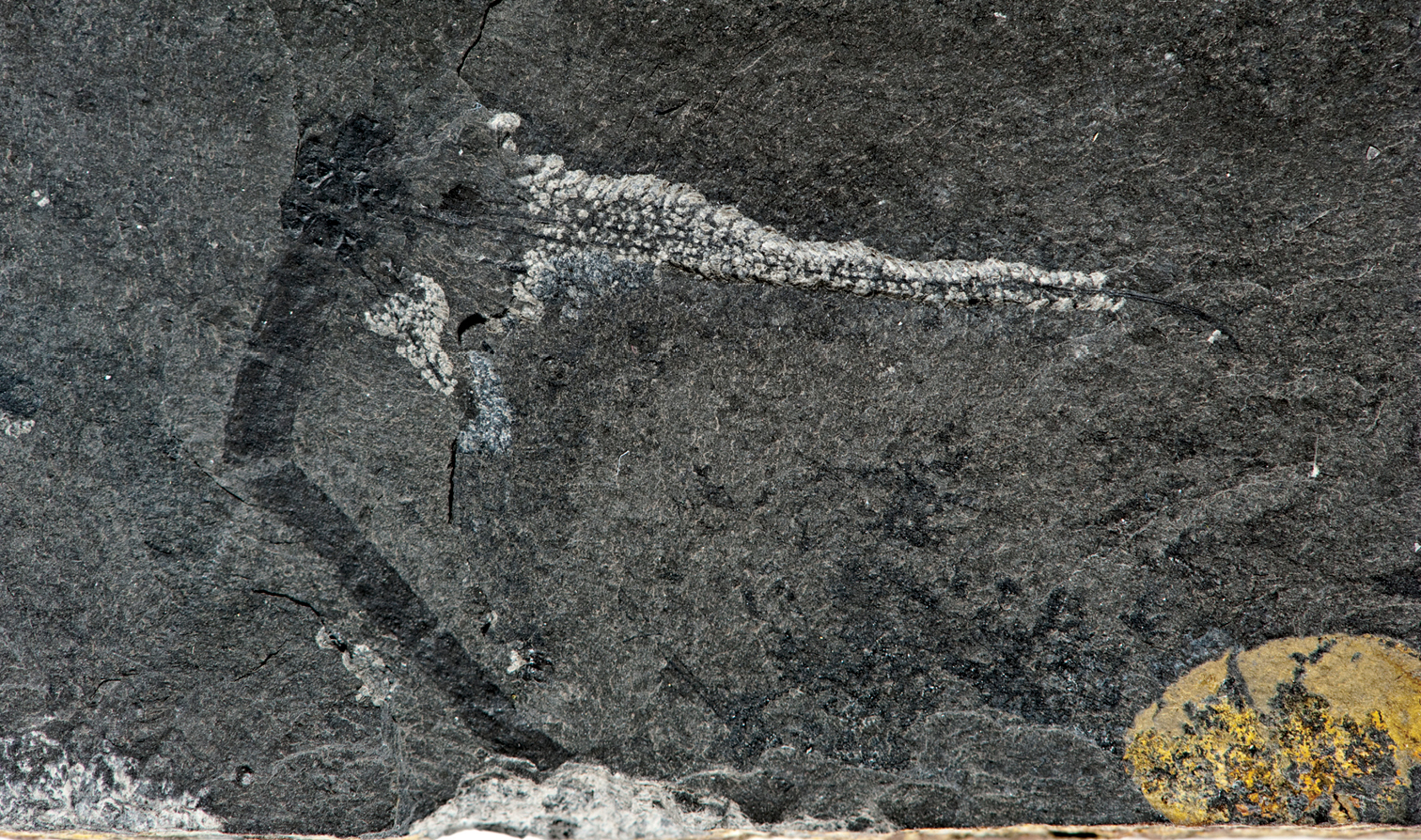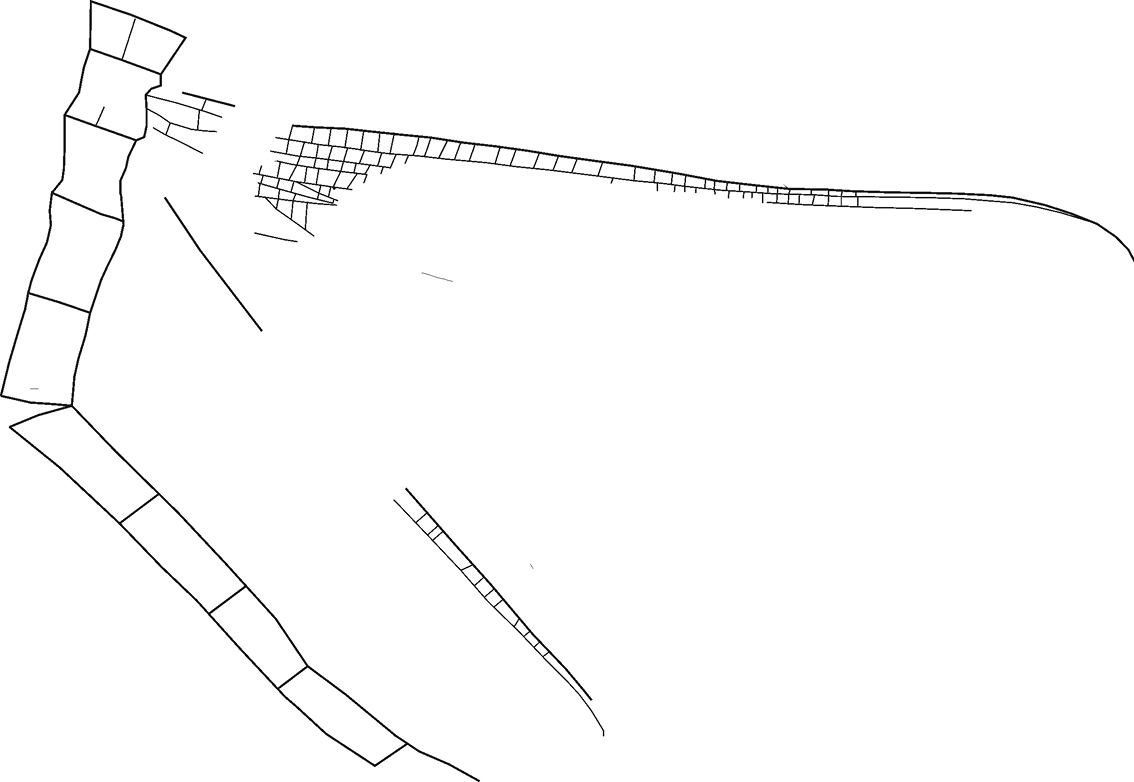






(C) 2011 Wolfgang Zessin. This is an open access article distributed under the terms of the Creative Commons Attribution License, which permits unrestricted use, distribution, and reproduction in any medium, provided the original author and source are credited.
For reference, use of the paginated PDF or printed version of this article is recommended.
Besides Erasipteroides valentini (Brauckmann in Brauckmann, Koch & Kemper, 1985), Zessinella siope Brauckmann, 1988, and Namurotypus sippeli Brauckmann & Zessin, 1989, Rasnitsynala sigambrorum gen. et sp. n. is the fourth species of the Odonatoptera from the early Late Carboniferous (Early Pennsylvanian: Namurian B, Marsdenian) deposits of the important Hagen-Vorhalle Konservat-Lagerstätte in Germany. With its wing-span of about 55 mm it is unusually small even for the “Eomeganisoptera”. Its venation resembles other small “Eomeganisoptera”, in particular Zessinella siope. This is why it is here assigned to the probably paraphyletic “Erasipteridae” Carpenter, 1939.
Odonatoptera, “Eomeganisoptera”, “Erasipteridae”, gen. et sp. n., early Late Carboniferous, Namurian B, Marsdenian, Hagen-Vorhalle, Germany
Up to now three species of Odonatoptera: Neodonatoptera have been described from early Late Carboniferous (Early Pennsylvanian: Namurian B, Marsdenian) deposits of the important Konservat-Lagerstätte of Hagen-Vorhalle in Germany, i.e. Erasipteroides valentini (Brauckmann in Brauckmann, Koch & Kemper, 1985), Zessinella siope Brauckmann, 1988 (both “Eomeganisoptera”: “Erasipteridae”) and Namurotypus sippeli Brauckmann & Zessin, 1989 (Euodonatoptera: Meganisoptera). Due to the nearly completely preserved specimens, in particular Erasipteroides valentini and Namurotypus sippeli enlarged the knowledge of the morphology and presumed behaviour of Late Palaeozoic Odonatoptera essentially (
The previously described species from Hagen-Vorhalle are among several findings of Odonatoptera from other Late Carboniferous (Pennsylvanian) collecting sites, in particular in Germany (
The nomenclature of the wing venation follows
The photograph and drawing of the holotype was prepared by digital camera Nikon D3 and Corel Draw 12.
Systematic palaeontologyRemarks. The systematics of early Odonatoptera as used in the present article follows
Odonatoptera Martynov, 1932 = Libellulidea sensu Rasnitsyn & Pritykina, 2002
Neodonatoptera Bechly, 1996
“Eomeganisoptera” Rohdendorf, 1962
“Erasipteridae” Carpenter, 1939
Remarks. As shown by
urn:lsid:zoobank.org:act:E891FF93-B6B1-4E57-B5DE-0019871FEAE2
Rasnitsynala sigambrorum gen. et sp. n.
As for the type species (due to the temporarily monospecific status). Thus far the physically smallest genus of the “Erasipteridae” with typical morphology of distal venation: kink between CuA+ and CuP– very short, ICu area forming a high triangle, and angle between AA1+ and CuA+ nearly 45°.
In its general characters (small size, venation, and cell configuration) Rasnitsynala gen. n. closely resembles the previously described genera of the “Erasipteridae” as defined by
Aulertupus tembrocki Zessin & Brauckmann 2010, holotype, left mesothoracic wing, preserved length 63 mm; Late Carboniferous (Pennsylvanian): Westphalian C/D; Morris, Mazon Creek, Illinois, USA, nomenclature of wing venation. From
In honour of Professor Dr Alexandr P. Rasnitsyn (Moscow).
urn:lsid:zoobank.org:act:2DA218E6-D010-45C2-9763-5C78DC7F0758
http://species-id.net/wiki/Rasnitsynala_sigambrorum
Figs 2 –3Former Sippel collection no. 182 A and B, now collection of the LWL-Museum für Naturkunde, Westfälisches Landesmuseum mit Planetarium in Münster (Germany), positive imprint: no. WMf.N P27781, negative imprint: no. WMf.N N3182B.
Abandoned brickyard quarry in Hagen-Vorhalle, North Rhine-Westphalia, Germany (topographic map 1 : 25, 000 sheet no. 4610 Hagen/Westfalen; 51°22.88'N; 007°26.77'E, ~115 m a.s.l.).
Early Late Carboniferous (Early Pennsylvanian: late Namurian B, late Marsdenian), Ziegelschiefer Formation.
Thus far the smallest species of the „Erasipteridae“ with the following main characters: Mesothoracic wing: (i) Length: 27 mm; (ii) anterior margin very slightly convex; (iii) ScP– very long, nearly reaching apex; (iv) subcostal area (Sc area) distally very narrow between ScP– and “PC/CA+/CP–/ScA+”; (v) AA1+ short, forming an angle of about 45° with Cu and CuA+; (vi) basal parts of CuA+ and CuP– rather long; (vii) basal intercubital area (ICu area) a relatively high triangle with its point downwards; (viii) kink between CuA+ and CuP– very short. Metathoracic wing: (i) Length: 22 mm; (ii) anterior margin very slightly convex. Body: (i) Preserved length (without head and posterior 3 abdominal segments): 24.5 mm, estimated total length: 32 mm; (ii) abdominal segments narrow and long.
Rasnitsynala sigambrorum gen. et sp. n., holotype, former Sippel collection no. 182 A, now collection of the LWL-Museum für Naturkunde, Westfälisches Landesmuseum mit Planetarium in Münster (Germany), positive imprint WMf.N P27781, nearly complete specimen; Early Late Carboniferous (Early Pennsylvanian: Namurian B, Marsdenian); abandoned brickyard quarry, Hagen-Vorhalle (Germany). Preserved length (= without head and posterior three segments): 24, 5 mm, length of mesothoracic wing: 27 mm. Photograph by LWL- Museum für Naturkunde, Berenika Oblonczyk.
Drawing of Rasnitsynala sigambrorum gen. et sp. n., holotype, former Sippel collection no. 182 A, now collection of the LWL-Museum für Naturkunde, Westfälisches Landesmuseum mit Planetarium in Münster (Germany), positive imprint WMf.N P27781, nearly complete specimen; Early Late Carboniferous (Early Pennsylvanian: Namurian B, Marsdenian); abandoned brickyard quarry, Hagen-Vorhalle (Germany). Body structure schematized. Preserved length (= without head and posterior three segments): 24.5 mm, length of mesothoracic wing: 27 mm. Drawing by Wolfgang Zessin, Jasnitz (Germany).
The rather well preserved fossil lies in dorsal view. The head with antennae, legs, the posterior three abdominal segments and the left wings are lacking as well as the posterior regions of the right wings. Nevertheless, the preserved parts of the right wings clearly exhibit the main diagnostic features. The original corrugation is nearly completely flattened by tectonic processes but can be reconstructed by comparison with the characters of the ground plan (
(i) Length of mesothoracic wing, 27; (ii) length of metathoracic wing, 22; (iii) preserved length of body (without posterior three abdominal segments), 24.5, estimated total length, 32.
Mesothoracic wing: Anterior margin very slightly convex; ScP– very long, nearly reaching apex; subcostal area (Sc area) distally very narrow between ScP– and complex PC/CA+/CP–/ScA+; AA1+ short, forming an angle of about 45° with Cu and CuA+; basal parts of CuA+ and CuP– rather long; basal intercubital area (ICu area) resembling a relatively high triangle with its point downwards; kink between CuA+ and CuP– very short. Metathoracic wing: Anterior margin very slightly convex, nearly straight. Body: Abdominal segments slender and long.
After the Latin name of the Germanic tribe Sigambri (or Sugambri) who inhabited the type region of the species.
With a wing-span of about 55mm, Rasnitsynala sigambrorum gen. et sp. n. represents the smallest species known to date of the presumably paraphyletic “Erasipteridae”. It shows some characters already known from the very plesiomorphic Geroptera: Eugeropteridae (metathoracic wing of Eugeropteron lunatum Riek in Riek & Kukalová-Peck, 1984) or Meganisoptera: Aulertupidae (Aulertupus tembrocki), e.g. (i) the morphology of the intercubital area (ICu area) and (ii) the course of AA1+. The abdominal morphology is unknown in most Palaeozoic Odonatoptera and cannot be compered. In Rasnitsynala sigambrorum gen. et sp. n. it is extremely slender and longer than the wings. It is even relatively longer and narrower than in the contemporaneous Namurotypus sippeli and Erasipteroides valentini but seems to be similar in Zessinella siope, again of the same age and locality. This character is common in several Recent Zygoptera. It demonstrates that the basic ground plan of Odonatoptera was already established in the very early phase of their evolution, presumably long before the Namurian B (about 319 m.y. ago).
Though extremely rare, Late Palaeozoic Odonatoptera are famous for the giant size of some of their species with a wing-span of more than 70 cm. On the other hand, Rasnitsynala sigambrorum gen. et sp. n. shows once more that they include small relatives, too. Previous collections were largely accidental or concentrated on easily recognizable moderate to large insects. We expect that focussing further prospection onto small and tiny species will significantly broaden our knowledge of early Hexapoda. Another vivid example for this is most recently given by
We are grateful to the following persons: Wolfgang Sippel (Ennepetal, Germany) who discovered and prepared the specimen, Alfred Hendricks and Lothar Schöllmann (both Münster, Germany) for providing the specimen, Jan-Michael Ilger (Clausthal-Zellerfeld, Germany) for helpful suggestions, Jarmila Kukalová-Peck (Ottawa, Canada) as well as Alexandr P. Rasnitsyn (Moscow, Russia) for general discussions and help during the last 30 years, and Roy J. Beckemeyer (Wichita, USA) for linguistic corrections. Additionally CB gratefully acknowledges the financial support by the DFG (Deutsche Forschungsgemeinschaft) for project BR 1253/4-1 (Hagen-Vorhalle). The anonymous referees are thanked for their constructive reviews.


